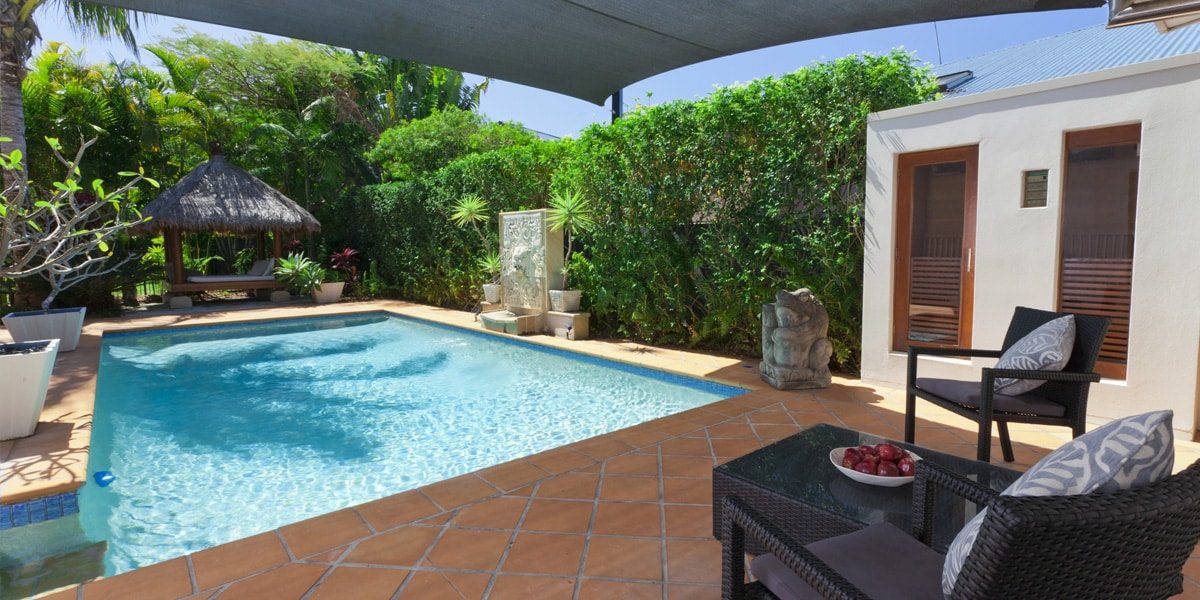Are you dreaming about installing a refreshing backyard pool for fun family memories this coming summer? Checking out glistening Instagram photos of beautiful pools and thinking – you want one too!
Before you dive in, you should wade through what’s involved with putting in your own pool. Traditional pools come with sustainability issues you should know about. However, the hot new trend is sustainable do-it-yourself backyard pools. Read on to learn why this new movement puts the control back in your hands to make an eco-friendly oasis that saves on energy and expenses down the road.
When estimating your expenses on a new pool, consider long term costs not just initial price tags. A little planning goes a long way to relax and float your cares away without draining your wallet!
Problems With Old School Pools
When picturing classic in-ground pools, what likely comes to mind is a large hole framed in concrete, filled with glistening blue water, surrounded by vast manicured lawns. Chances are there’s someone blissfully floating around without a care in the world thanks to this backyard paradise.
While there’s no denying that pools equal summertime fun, traditional pools come with substantial sustainability issues you may not realize. Now review key areas where standard pools fall short when it comes to eco-friendliness.
Running Up Your Energy Bill
To operate properly, pools rely on water circulation plus heating and cleaning systems that require considerable energy to run. Using older equipment like single speed pumps and outdated heating units sucks up a lot of power.
In fact, after hot water heaters and AC units, swimming pools rank as the third biggest energy guzzling culprit in most homes! Just heating and circulating all that water can really add up, not to mention powering energy draining pool lights. Converting to eco-friendly equipment can trim energy needs.
Dumping In Chemicals
You’ve likely heard the expression, “A pint of sweat saves a gallon of cure.” Well when it comes to pool maintenance, ounces of chlorine prevent pounds of problems down the line! Proper water chemistry keeps pools clean and swimmers healthy by eliminating bacteria and algae.
However, traditional chlorine and bromine sanitizing chemicals come with environmental drawbacks. The production and packaging of pool chemicals leave substantial carbon footprints. In addition, toxins and nutrient pollution are released when used pool water is drained or backwashed without being treated first.
Using automated cleaning systems and alternative mineral-based disinfection methods significantly reduce the need for harsh pool chemicals. Less chemicals equals less manufacturing and less pollution.
Draining Precious Fresh Water
Filling a pool requires thousands of gallons of precious fresh water. What’s more, frequently backwashing traditional sand filters to rinse out debris consumes a lot of H2O – up to 1,500 gallons monthly per pool!
Integrating eco-friendly cartridge filters use far less water to clean than sand filters. Capturing rain in above ground tanks offers renewable filler water rather than constantly tapping into municipal supplies every season. Installing covers and optimizing circulation cuts back on evaporation and the need for frequent top-ups too.
In total, classic pools rack up eye-popping utility and water bills, not to mention costs associated with regular chemical replenishments and maintenance requirements.
Why Take the Sustainable Plunge?
Constructing your own energy efficient Green Pool aligned with nature makes all kinds of sense! Time to review top reasons savvy homeowners are taking the eco-friendly DIY swimming pool plunge.
Slash Energy Consumption
Choosing sustainable technology when building or upgrading means tapping into natural energy sources like the sun and breezes rather than only pulling from the grid. Solar systems harness free heat while windbreak trees cut wind-driven evaporation.
Strategic choices like installing LED lighting, high efficiency pumps and covers drastically reduce electricity usage. Automating heating and cleaning functions to run only when needed prevents energy waste too. Ultimately you save money while treading lighter on the planet all at once.
Minimize Use of Harsh Chemicals
Reducing reliance on heavy duty pool chemicals starts with sustainable construction planning. Sloping walls prevent algae-spreading cold spots while smooth surfaces leave nowhere for bio-gunk to hide. Dividing your pool into dual-purpose zones allows aquatic plants in regeneration areas to naturally filter water.
Opting for eco-friendly sanitation like mineral sticks or salt chlorinators cuts back on tons of chemical manufacturing and packaging waste without sacrificing cleanliness. Bonus – no more itchy eyes or funky chlorine smells lingering on your skin and suits either!
Conserve Precious Water
Building water savings into pool construction represents true sustainability. Collecting rainfall in catch tanks eliminates tapping into precious potable supplies for make-up water post-construction or seasonal refills. Installing cartridge filters uses 80% less H2O during backwashing than old school sand options.
Pool water lost to evaporation gets cut by adding a liquid cover solution or floating solar blankets. Reduced water loss means you refill less often, saving resources plus money on your bills to boot! Carefully designing depth and integrating solar heat retention cuts heating costs too for a double whammy of savings!
When costing a new pool, calculating long term costs around sustainability measures pays you back over time with money in the bank.
Dive Into Additional Options
If going fully green with a 100% chemical-free natural pool ecosystem appeals to your inner environmentalist, this represents the ultimate in sustainable pool construction! Using strategically placed aquatic plants as natural biological filters eliminates sanitizers entirely in favor of balanced contained ecosystems. However, more oversight is needed to maintain ideal mineral levels, pH, and beneficial bacteria compared to low-chemical pools.
For those seeking a balanced middle path, installing alternative sanitation systems significantly reduces traditional chemical usage. Mineral sticks infuse sanitizing silver and copper ions via erosion while salt chlorination units electrolyze salts into cleansing hypochlorous acid onsite as needed. Reduced manufacturing waste plus gentler sanitizers add up to solid eco-wins. However, supplemental shocking and clarifying may still be periodically needed with heavy bather loads.
Finally, for bonus conservation points don’t disregard repurposing your backwashed filter water before surcharging groundwater supplies! Diluting and distributing rinsed debris as landscape irrigation avoids nutrient pollution while nurturing gardens. Check local bylaws, but this recycling route keeps H20 and nutrients beneficially in use rather than sending them down the drain.
Closing Thoughts
As you can see, installing your own eco-friendly DIY swimming pool aligns with care for creation principles in numerous ways beyond weekend enjoyment for your family! When calculating your expenses on a new pool, savings over the long run outweigh moderate initial investments into quality and efficiency. Plus you gain serious greenie bragging rights in the neighborhood!
Here’s to swimming with sustainability top of mind in your own refreshing backyard oasis sooner than later this season! Dive into a new wave of clean energy savings, reduced chemical usage and replenishing precious water resources via rain harvesting as you make environmentally-conscious ripples for future generations to come. The weather is warming up – happy sun-safe splashing!
Published by: Martin De Juan



















